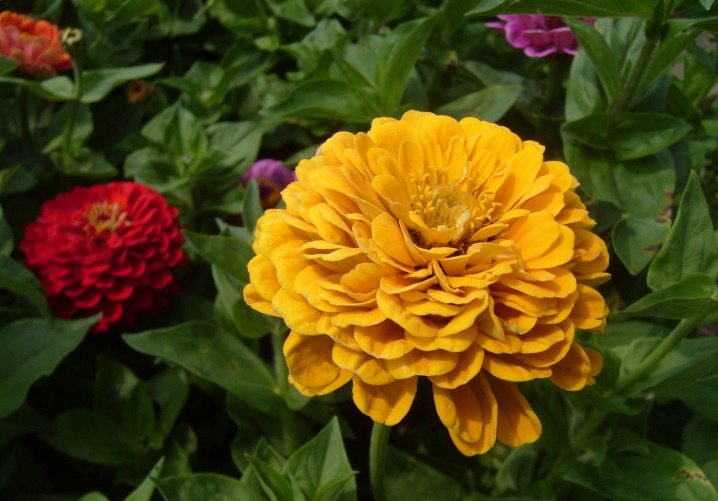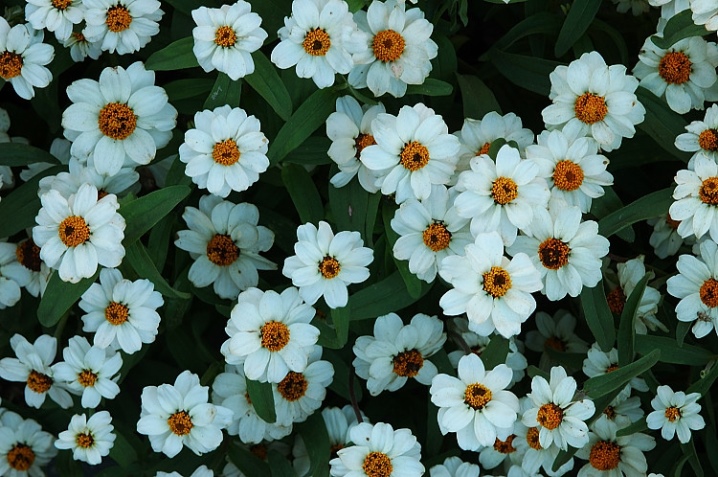Overview of species and varieties of zinnia

Zinnia is a popular plant loved by many gardeners (both experienced and novice). The flower is quite unpretentious in terms of grooming measures. In addition, it is distinguished by its extraordinary beauty and variety: today you can find zinnia seeds of almost any shade in the flower markets. What types and varieties of zinnias are there? How to choose the right plant? Read more about this in our material.



What colors are there?
According to botanical features, zinnia is a flowering shrub with stems that can be in several positions (standing upright or spreading out). By their structure, the stems of the plant are quite elastic, and on their surface they have a small edge. Zinnia belongs to the Astrov family. The flowering period of the plant falls in summer-autumn (the specific duration of flowering depends on the species and variety). Zinnia is a plant that is striking in its diversity. So, in nature there are varieties of zinnias of the most different, sometimes even incredible shades. Zinnia can be:
- white;
- yellow;
- pink;
- orange;
- red;
- purple, etc.
Besides, in addition to monochromatic colors, in nature you can find zinnias, which combine several shades: for example, orange and yellow, pink and white, etc. Thus, regardless of your individual preferences and aesthetic tastes, you can find a zinnia variety that suits you specifically and fits perfectly into the landscape design of your site.




Overview of popular species
Today, botanists distinguish a large number of species and types of zinnia: dwarf, undersized, bush, dahlia, border. In our today's material, we will take a closer look at the most common and popular types of this plant.


Graceful
The graceful zinnia (or Zinnia elegans) is the most popular and widespread species of this plant. It is believed that the birthplace of the flower is Mexico.
Plants belonging to this species can reach 1 meter in height.
Wherein zinnia has rather rigid branchy shoots in its structure... They also have specific hairs. The leaves of the plant are oval and have no petioles. In addition, they are classified as pubescent. The shoots of the plant, which are located on the sides, have flower baskets at the ends, the diameter of which ranges from 5 to 14 cm.

The flowers of the plant have a terry texture and have peduncles that are characterized by increased rigidity. Also of note is the fact that graceful zinnia exists naturally in a wide variety of colors (including colors such as purple, white, orange, etc.). The flowering period of graceful zinnia occurs in summer and autumn (most often from June to October). By its botanical nature, Zinnia elegans belongs to the category of annual plants. Most often, the flower is sown in the first half of spring. At the same time, zinnia can be sown both in boxes for seedlings and in open soil.


Linearis
This type of zinnia is truly considered the smallest. If we talk about the similarity of linearis with other subspecies of zinnia, then it is worth noting that this plant is similar in appearance to the narrow-leaved type. In height, the bushes of the plants reach an indicator of 0.35 meters. Moreover, they have rather narrow bushes in their shape.The color of the plant is of great interest to professional botanists, experienced gardeners and beginners, since it is quite unique in nature. So, linearis has orange inflorescences with yellow edges.

Due to its compact size and relative unpretentiousness in care, linearis can be grown not only in a garden area, but also in small flower beds or pots (for example, on a balcony).
Narrow-leaved
Another popular variety of zinnia is zinnia angustifolia (or Zinnia angustifolia). This plant will be an excellent decoration for any site: both your private front garden and public territory. It should be noted right away that the plant is rather small in size. So, the maximum height of a flower can reach only 0.4 meters. On the other hand, gardeners point out that Zinnia angustifolia is more lush in shape than some other species of this plant..


The flowering period is traditionally between July and October. It is important to note that the first inflorescences appear 10 weeks after the direct sowing of zinnia.
Many gardeners prefer Zinnia angustifolia to other species due to its resistance to diseases and pests.

Fine-flowered
The Latin name for fine-flowered zinnia is Zinnia tenuiflora. Zinnia grows in the form of bushes of moderate spreading. These shrubs reach a height of 0.6 meters. The plant is distinguished by thin stems that have a geniculate structure. These stems are colored in different shades of brown and red. The diameter of the inflorescence of fine-flowered zinnia ranges from 2.5 to 3 cm. Moreover, the flowers themselves have a rather narrow shape and are slightly bent back, and even twisted at the ends. Zinnia flowers of this species are colored dark red. Highly often this plant is used in landscape design to create complex flower arrangements, planting around flower beds or paths, as well as for decorating lawns.

Description of the best varieties
Consider the most popular and best zinnias.
"Lilliputian"
Zinnia "Lilliput" has quite large flowers. So, their diameter is about 10 cm. Moreover, the flowers themselves have a dome-shaped shape and a double texture. Variety "Lilliput" in height can reach 0.5 meters. The plant belongs to the thermophilic category, therefore, it is very important to ensure the optimal temperature during the care process. The flowering process begins 3 months after the first shoots have appeared. It lasts a long time and is very intense.

Due to the fact that "Lilliput" has flowers of bright colors, it is often used in landscape design. For example, a plant will look great in a flower bed.
"Lilliput" can be planted both independently and in combination with other varieties of zinnia, or even with other plants (marigolds, marigolds, verbena, etc.).
"Dreamland"
This botany variety belongs to the category of low-growing and compact plants, due to the fact that the height of the zinnia "Dreamland" grows only up to 0.25 m. At the same time, the variety is distinguished by a rather intense flowering. Variety "Dreamland" belongs to the dahlia-flowered subspecies. It is quite resistant to various kinds of diseases and pests. It is also worth noting the fact that "Dreamland" can be grown not only in the open field, but also in pots at home.


Magellan
This variety of zinnias belongs to the graceful species and is distinguished by its unpretentiousness in terms of care. It should be noted right away that the Magellan variety was bred exclusively for decorative purposes. In this regard, the plant is often grown not only outdoors, but also in flower beds, pots and containers. Among the representatives of the Magellan variety, you can find specimens of various shades.Moreover, the flowers have a double texture, and the plants themselves are insignificant in size.



"Persian rug"
The Persian carpet variety, which got its name from its color, amazes both experienced gardeners and beginners. This effect is created due to the unique color of the flower, which combines several shades at once: yellow, brown and red tones. At the same time, heterogeneous blotches can often be found on the petals of flowers. By themselves, zinnia flowers of the "Persian carpet" variety in diameter can reach 5 centimeters. Due to such an unusual appearance, zinnias belonging to this variety can become a real decoration of your garden. They will make an indelible impression on both your household and neighbors, as well as bystanders.


"Profusion"
This flower variety belongs to the category of annuals. Zinnia of the "Profusion" variety is a low-growing plant with a homogeneous structure. It can be grown both in flower beds and in pots or containers. The plant has a fairly strong and well-developed root system. It is quite simple to grow it, so very often beginners in gardening give preference to this particular variety of zinnias. The flower tolerates a variety of climatic conditions, so it can be grown in all regions of our country.


Also, the "Profusion" variety is highly resistant to various kinds of diseases, as well as to pests.
"Double Zakhara"
Representatives of this variety, contrary to popular belief, are not perennial plants. On the contrary, they are annuals. Among this variety, you can find a real mix of colors. In height, the bushes of the variety can reach 50 cm, and the width does not exceed 40 cm.The diameter of the flowers is quite large and is 6 cm.

Benari Giants
As you might guess from the name of the variety, its peculiarity is the flowers, which are quite large in diameter, which can be painted in a variety of colors.



"California giants"
Just like the previous variety, "California Giants" are plants that are distinguished by their large flower sizes (up to 14 cm).
Moreover, the bush itself can reach a height of 80 cm.
The plant belongs to the thermophilic category.

"Topolino"
The flowers of this variety are distinguished by their double texture. The height of the bushes usually does not exceed 0.6 meters, but at the same time they are distinguished by a pronounced strength.



How to choose?
Choosing a specific zinnia variety for your garden is a demanding and difficult task. When choosing a plant, it is important to pay attention to several factors. First of all, you should carefully read the rules of planting and caring for the plant. Make sure that the flower on your site can actively grow and develop and will not be constrained by any external factors (for example, soil composition, temperature regime, light, etc.).

In addition, try to assess your strengths in advance and decide if you can provide all the necessary care measures that the plant requires in its relation. Otherwise, the flower may simply die.
After you are convinced that you have the opportunity to provide all the necessary conditions for the active growth and development of the flower, you should pay attention to the external characteristics of the plant. So, zinnias, depending on the species and the specific variety, differ significantly in their external characteristics (height, spreading, color, etc.). It is important to make sure you give the plant sufficient space.


If you are planting zinnia as an ornamental plant, then you should think over all possible color variations in advance. So, today in nature there is a huge number of different colors of zinnias: red, white, purple, orange, etc.You can choose one of the types to create an organic uniform composition, or you can combine several varieties of plants to create a bright color accent in your area. In case of difficulty, it is recommended to contact a professional landscape designer.

All about the cultivation and care of zinnia, see the video.



































































































The comment was sent successfully.